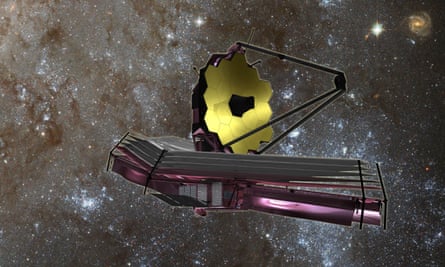Astronomers detect ‘waterworld with a boiling ocean’ in deep draw – Guardian

Astronomers occupy noticed a a lot away planet that shall be fully lined in a deep water ocean, in findings that arrangement the glimpse for liveable conditions previous Earth.
The observations, by Nasa’s James Webb draw telescope (JWST), printed water vapour and chemical signatures of methane and carbon dioxide in the ambiance of the exoplanet, which is twice Earth’s radius and about 70 light years away. This chemical mix is in accordance to a water world where the ocean would span the general surface, and a hydrogen-smartly to establish ambiance, in accordance to researchers from the College of Cambridge, though they originate no longer envisage a balmy, sharp seascape.
“The ocean shall be upwards of 100 degrees [Celsius] or more,” mentioned Prof Nikku Madhusudhan, who led the diagnosis. At excessive atmospheric stress, an ocean this scorching could also peaceful be liquid, “nonetheless it’s no longer decided if it would be liveable,” he added.
This interpretation is favoured in a paper published in the journal Astronomy and Astrophysics Letters, nonetheless is disputed by a Canadian crew that made additional observations of the identical exoplanet, which is acknowledged as TOI-270 d. They detected the identical atmospheric chemicals nonetheless argue the planet shall be too scorching for liquid water – presumably 4,000C – and as an replacement would feature a rocky surface topped by an incredibly dense ambiance of hydrogen and water vapour.
Whichever glimpse wins out, these most in style observations showcase the dazzling insights James Webb is giving into the character of planets previous our solar system. The telescope captures the starlight that has been filtered by arrangement of the atmospheres of orbiting planets to give detailed breakdowns of the chemical parts recent. From this, astronomers can originate up a image of conditions at a planet’s surface – and the likelihood of existence being ready to outlive there.
The evidence for TOI-270 d’s ocean is primarily based fully on the absence of ammonia, which classic chemistry predicts can occupy to peaceful occur naturally in a hydrogen-smartly to establish ambiance. But ammonia is highly soluble in water and so shall be depleted in the ambiance if there had been an ocean down below. “One interpretation is that here’s a so-known as ‘hycean’ world – with a water ocean below a hydrogen-smartly to establish ambiance,” mentioned Madhusudhan.
Conditions shall be very thoroughly different from these on Earth. TOI-270 d is tidally locked, meaning one aspect permanently faces its huge establish and thoroughly different is bathed in eternal darkness, organising an impolite temperature distinction.

“The ocean shall be extraordinarily scorching on the day aspect. The evening aspect could also potentially host liveable conditions,” mentioned Madhusudhan. But there shall be a crushing ambiance, with tens or hundreds of instances the stress on the Earth’s surface, and steam rolling off the ocean. The waters have a tendency to succeed in depths of tens to hundreds of kilometres, with a excessive-stress ice seabed, and below that a rocky core.
Prof Björn Benneke, of the College of Montreal, has conducted additional observations of the planet and questions the “hycean world” hypothesis. “The temperature in our glimpse is too warmth for water to be liquid,” he mentioned, along side that the ambiance perceived to contain mountainous quantities of water vapour – too unprecedented for the existence of an ocean to be plausible. On the surface, temperatures could also attain 4000C, Benneke estimates, with water gift in a supercritical reveal, where the respect between a liquid and gasoline becomes blurred. “It’s almost esteem a thick, scorching fluid,” he mentioned.
Both groups detected carbon disulphide, which is linked to biological processes on Earth, nonetheless that would also just additionally be produced by thoroughly different sources. On the opposite hand, there was no imprint of one other biosignature molecule, dimethyl sulphide (DMS).
“We are in a position to’t tie [carbon disulphide] to biological job,” mentioned Madhusudhan. “In a hydrogen-smartly to establish ambiance, it is a ways somewhat straightforward to originate it. But when we’re ready to measure the abnormal molecule it’s promising that we wants in an effort to measure liveable planets in the waste.
“We can occupy to peaceful be extraordinarily careful about how we keep in touch findings on this roughly object,” he added. “It’s straightforward for the public to jump on to the premise that we’re discovering existence already.”
Dr Jo Barstow, an astronomer on the Start College who was no longer desirous in regards to essentially the most in style work, mentioned: “Spectra of these dinky planets with JWST are in spite of everything thrilling due to these are ticket new environments for which we haven’t any solar system identical.”
Barstow added that additional observations to pin down the abundance of water vapour in the ambiance would back justify the likelihood of an ocean. “It’s in spite of everything attention-grabbing and in spite of everything nice that two groups occupy regarded on the identical dataset and shall be found up with the identical chemical make-up,” she added.


